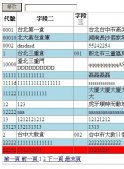JWT認(rèn)證簡單介紹
關(guān)于Jwt的介紹網(wǎng)上很多,此處不在贅述,我們主要看看jwt的結(jié)構(gòu)。
JWT主要由三部分組成,如下:
|
1
|
HEADER.PAYLOAD.SIGNATURE |
HEADER 包含token的元數(shù)據(jù),主要是加密算法,和簽名的類型,如下面的信息,說明了
加密的對象類型是JWT,加密算法是HMAC SHA-256
|
1
|
{"alg":"HS256","typ":"JWT"} |
然后需要通過BASE64編碼后存入token中
|
1
|
eyJhbGciOiJIUzI1NiIsInR5cCI6IkpXVCJ9 |
Payload 主要包含一些聲明信息(claim),這些聲明是key-value對的數(shù)據(jù)結(jié)構(gòu)。
通常如用戶名,角色等信息,過期日期等,因為是未加密的,所以不建議存放敏感信息。
|
1
|
{"http://schemas.xmlsoap.org/ws/2005/05/identity/claims/name":"admin","exp":1578645536,"iss":"webapi.cn","aud":"WebApi"} |
也需要通過BASE64編碼后存入token中
|
1
|
eyJodHRwOi8vc2NoZW1hcy54bWxzb2FwLm9yZy93cy8yMDA1LzA1L2lkZW50aXR5L2NsYWltcy9uYW1lIjoiYWRtaW4iLCJleHAiOjE1Nzg2NDU1MzYsImlzcyI6IndlYmFwaS5jbiIsImF1ZCI6IldlYkFwaSJ9 |
Signature jwt要符合jws(Json Web Signature)的標(biāo)準(zhǔn)生成一個最終的簽名。把編碼后的Header和Payload信息加在一起,然后使用一個強加密算法,如 HmacSHA256,進(jìn)行加密。HS256(BASE64(Header).Base64(Payload),secret)
|
1
|
2_akEH40LR2QWekgjm8Tt3lesSbKtDethmJMo_3jpF4 |
最后生成的token如下
|
1
|
eyJhbGciOiJIUzI1NiIsInR5cCI6IkpXVCJ9.eyJodHRwOi8vc2NoZW1hcy54bWxzb2FwLm9yZy93cy8yMDA1LzA1L2lkZW50aXR5L2NsYWltcy9uYW1lIjoiYWRtaW4iLCJleHAiOjE1Nzg2NDU1MzYsImlzcyI6IndlYmFwaS5jbiIsImF1ZCI6IldlYkFwaSJ9.2_akEH40LR2QWekgjm8Tt3lesSbKtDethmJMo_3jpF4 |
開發(fā)環(huán)境
框架:asp.net 3.1
IDE:VS2019
ASP.NET 3.1 Webapi中使用JWT認(rèn)證
命令行中執(zhí)行執(zhí)行以下命令,創(chuàng)建webapix項目:
|
1
|
dotnet new webapi -n Webapi -o WebApi |
特別注意的時,3.x默認(rèn)是沒有jwt的Microsoft.AspNetCore.Authentication.JwtBearer庫的,所以需要手動添加NuGet Package,切換到項目所在目錄,執(zhí)行 .net cli命令
|
1
|
dotnet add package Microsoft.AspNetCore.Authentication.JwtBearer --version 3.1.0 |
創(chuàng)建一個簡單的POCO類,用來存儲簽發(fā)或者驗證jwt時用到的信息
|
1
2
3
4
5
6
7
8
9
10
11
12
13
14
15
16
17
18
19
20
21
22
23
24
25
26
27
|
using Newtonsoft.Json;using System;using System.Collections.Generic;using System.Linq;using System.Threading.Tasks;namespace Webapi.Models{ public class TokenManagement { [JsonProperty("secret")] public string Secret { get; set; } [JsonProperty("issuer")] public string Issuer { get; set; } [JsonProperty("audience")] public string Audience { get; set; } [JsonProperty("accessExpiration")] public int AccessExpiration { get; set; } [JsonProperty("refreshExpiration")] public int RefreshExpiration { get; set; } }} |
然后在 appsettings.Development.json 增加jwt使用到的配置信息(如果是生成環(huán)境在 appsettings.json 添加即可)
|
1
2
3
4
5
6
7
|
"tokenManagement": { "secret": "123456", "issuer": "webapi.cn", "audience": "WebApi", "accessExpiration": 30, "refreshExpiration": 60 } |
然后再startup類的ConfigureServices方法中增加讀取配置信息
|
1
2
3
4
5
6
7
|
public void ConfigureServices(IServiceCollection services) { services.AddControllers(); services.Configure<TokenManagement>(Configuration.GetSection("tokenManagement")); var token = Configuration.GetSection("tokenManagement").Get<TokenManagement>(); } |
到目前為止,我們完成了一些基礎(chǔ)工作,下面再webapi中注入jwt的驗證服務(wù),并在中間件管道中啟用authentication中間件。
startup類中要引用jwt驗證服務(wù)的命名空間
|
1
2
|
using Microsoft.AspNetCore.Authentication.JwtBearer;using Microsoft.IdentityModel.Tokens; |
然后在 ConfigureServices 方法中添加如下邏輯
|
1
2
3
4
5
6
7
8
9
10
11
12
13
14
15
16
17
18
|
services.AddAuthentication(x => { x.DefaultAuthenticateScheme = JwtBearerDefaults.AuthenticationScheme; x.DefaultChallengeScheme = JwtBearerDefaults.AuthenticationScheme; }).AddJwtBearer(x => { x.RequireHttpsMetadata = false; x.SaveToken = true; x.TokenValidationParameters = new TokenValidationParameters { ValidateIssuerSigningKey = true, IssuerSigningKey = new SymmetricSecurityKey(Encoding.ASCII.GetBytes(token.Secret)), ValidIssuer = token.Issuer, ValidAudience = token.Audience, ValidateIssuer = false, ValidateAudience = false }; }); |
再 Configure 方法中啟用驗證
|
1
2
3
4
5
6
7
8
9
10
11
12
13
14
15
16
17
18
19
|
public void Configure(IApplicationBuilder app, IWebHostEnvironment env) { if (env.IsDevelopment()) { app.UseDeveloperExceptionPage(); } app.UseHttpsRedirection(); app.UseAuthentication(); app.UseRouting(); app.UseAuthorization(); app.UseEndpoints(endpoints => { endpoints.MapControllers(); }); } |
上面完成了JWT驗證的功能,下面就需要增加簽發(fā)token的邏輯。我們需要增加一個專門用來用戶認(rèn)證和簽發(fā)token的控制器,命名成 AuthenticationController ,同時增加一個請求的DTO類
|
1
2
3
4
5
6
7
8
9
10
11
|
public class LoginRequestDTO { [Required] [JsonProperty("username")] public string Username { get; set; } [Required] [JsonProperty("password")] public string Password { get; set; } } |
|
1
2
3
4
5
6
7
8
9
10
11
12
13
14
15
16
17
|
[Route("api/[controller]")] [ApiController] public class AuthenticationController : ControllerBase { [AllowAnonymous] [HttpPost, Route("requestToken")] public ActionResult RequestToken([FromBody] LoginRequestDTO request) { if (!ModelState.IsValid) { return BadRequest("Invalid Request"); } return Ok(); } } |
目前上面的控制器只實現(xiàn)了基本的邏輯,下面我們要創(chuàng)建簽發(fā)token的服務(wù),去完成具體的業(yè)務(wù)。第一步我們先創(chuàng)建對應(yīng)的服務(wù)接口,命名為 IAuthenticateService
|
1
2
3
4
|
public interface IAuthenticateService { bool IsAuthenticated(LoginRequestDTO request, out string token); } |
接下來,實現(xiàn)接口
|
1
2
3
4
5
6
7
|
public class TokenAuthenticationService : IAuthenticateService { public bool IsAuthenticated(LoginRequestDTO request, out string token) { throw new NotImplementedException(); } } |
在 Startup 的 ConfigureServices 方法中注冊服務(wù)
|
1
|
services.AddScoped<IAuthenticateService, TokenAuthenticationService>(); |
在Controller中注入IAuthenticateService服務(wù),并完善action
|
1
2
3
4
5
6
7
8
9
10
11
12
13
14
15
16
17
18
19
20
21
22
23
24
25
26
|
public class AuthenticationController : ControllerBase { private readonly IAuthenticateService _authService; public AuthenticationController(IAuthenticateService authService) { this._authService = authService; } [AllowAnonymous] [HttpPost, Route("requestToken")] public ActionResult RequestToken([FromBody] LoginRequestDTO request) { if (!ModelState.IsValid) { return BadRequest("Invalid Request"); } string token; if (_authService.IsAuthenticated(request, out token)) { return Ok(token); } return BadRequest("Invalid Request"); } } |
正常情況,我們都會根據(jù)請求的用戶和密碼去驗證用戶是否合法,需要連接到數(shù)據(jù)庫獲取數(shù)據(jù)進(jìn)行校驗,我們這里為了方便,假設(shè)任何請求的用戶都是合法的。
這里單獨加個用戶管理的服務(wù),不在IAuthenticateService這個服務(wù)里面添加相應(yīng)邏輯,主要遵循了 職責(zé)單一原則 。首先和上面一樣,創(chuàng)建一個服務(wù)接口 IUserService
|
1
2
3
4
|
public interface IUserService { bool IsValid(LoginRequestDTO req); } |
實現(xiàn) IUserService 接口
|
1
2
3
4
5
6
7
8
|
public class UserService : IUserService { //模擬測試,默認(rèn)都是人為驗證有效 public bool IsValid(LoginRequestDTO req) { return true; } } |
同樣注冊到容器中
|
1
|
services.AddScoped<IUserService, UserService>(); |
接下來,就要完善TokenAuthenticationService簽發(fā)token的邏輯,首先要注入IUserService 和 TokenManagement,然后實現(xiàn)具體的業(yè)務(wù)邏輯,這個token的生成還是使用的Jwt的類庫提供的api,具體不詳細(xì)描述。
特別注意下TokenManagement的注入是已IOptions的接口類型注入的,還記得在Startpup中嗎?我們是通過配置項的方式注冊TokenManagement類型的。
|
1
2
3
4
5
6
7
8
9
10
11
12
13
14
15
16
17
18
19
20
21
22
23
24
25
26
27
28
|
public class TokenAuthenticationService : IAuthenticateService { private readonly IUserService _userService; private readonly TokenManagement _tokenManagement; public TokenAuthenticationService(IUserService userService, IOptions<TokenManagement> tokenManagement) { _userService = userService; _tokenManagement = tokenManagement.Value; } public bool IsAuthenticated(LoginRequestDTO request, out string token) { token = string.Empty; if (!_userService.IsValid(request)) return false; var claims = new[] { new Claim(ClaimTypes.Name,request.Username) }; var key = new SymmetricSecurityKey(Encoding.UTF8.GetBytes(_tokenManagement.Secret)); var credentials = new SigningCredentials(key, SecurityAlgorithms.HmacSha256); var jwtToken = new JwtSecurityToken(_tokenManagement.Issuer, _tokenManagement.Audience, claims, expires: DateTime.Now.AddMinutes(_tokenManagement.AccessExpiration), signingCredentials: credentials); token = new JwtSecurityTokenHandler().WriteToken(jwtToken); return true; } } |
準(zhǔn)備好測試試用的APi,打上Authorize特性,表明需要授權(quán)!
|
1
2
3
4
5
6
7
8
9
10
11
12
13
14
15
16
17
18
19
20
21
22
23
24
25
26
27
28
29
30
|
[ApiController] [Route("[controller]")] [Authorize] public class WeatherForecastController : ControllerBase { private static readonly string[] Summaries = new[] { "Freezing", "Bracing", "Chilly", "Cool", "Mild", "Warm", "Balmy", "Hot", "Sweltering", "Scorching" }; private readonly ILogger<WeatherForecastController> _logger; public WeatherForecastController(ILogger<WeatherForecastController> logger) { _logger = logger; } [HttpGet] public IEnumerable<WeatherForecast> Get() { var rng = new Random(); return Enumerable.Range(1, 5).Select(index => new WeatherForecast { Date = DateTime.Now.AddDays(index), TemperatureC = rng.Next(-20, 55), Summary = Summaries[rng.Next(Summaries.Length)] }) .ToArray(); } } |
支持我們可以測試驗證了,我們可以使用postman來進(jìn)行http請求,先啟動http服務(wù),獲取url,先測試一個訪問需要授權(quán)的接口,但沒有攜帶token信息,返回是401,表示未授權(quán)

下面我們先通過認(rèn)證接口,獲取token,居然報錯,查詢了下,發(fā)現(xiàn)HS256算法的秘鑰長度最新為128位,轉(zhuǎn)換成字符至少16字符,之前設(shè)置的秘鑰是123456,所以導(dǎo)致異常。
|
1
|
System.ArgumentOutOfRangeException: IDX10603: Decryption failed. Keys tried: 'HS256'. Exceptions caught: '128'. token: '48' (Parameter 'KeySize') at |
更新秘鑰
|
1
2
3
4
5
6
7
|
"tokenManagement": { "secret": "123456123456123456", "issuer": "webapi.cn", "audience": "WebApi", "accessExpiration": 30, "refreshExpiration": 60 } |
重新發(fā)起請求,成功獲取token
eyJhbGciOiJIUzI1NiIsInR5cCI6IkpXVCJ9.eyJodHRwOi8vc2NoZW1hcy54bWxzb2FwLm9yZy93cy8yMDA1LzA1L2lkZW50aXR5L2NsYWltcy9uYW1lIjoiYWRtaW4iLCJleHAiOjE1Nzg2NDUyMDMsImlzcyI6IndlYmFwaS5jbiIsImF1ZCI6IldlYkFwaSJ9.AehD8WTAnEtklof2OJsvg0U4_o8_SjdxmwUjzAiuI-o

把token帶到之前請求的api中,重新測試,成功獲取數(shù)據(jù)

基于token的認(rèn)證方式,讓我們構(gòu)建分布式/松耦合的系統(tǒng)更加容易。任何地方生成的token,只有擁有相同秘鑰,就可以再任何地方進(jìn)行簽名校驗。
當(dāng)然要用好jwt認(rèn)證方式,還有其他安全細(xì)節(jié)需要處理,比如palyload中不能存放敏感信息,使用https的加密傳輸方式等等,可以根據(jù)業(yè)務(wù)實際需要再進(jìn)一步安全加固!
同時我們也發(fā)現(xiàn)使用token,就可以擺脫cookie的限制,所以JWT是移動app開發(fā)的首選!
以上就是本文的全部內(nèi)容,希望對大家的學(xué)習(xí)有所幫助,也希望大家多多支持服務(wù)器之家。
原文鏈接:https://www.cnblogs.com/liuww/p/12177272.html












